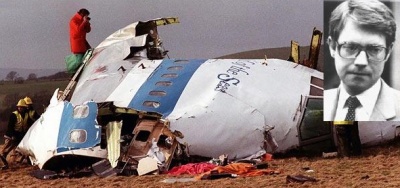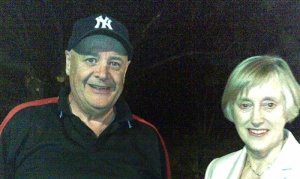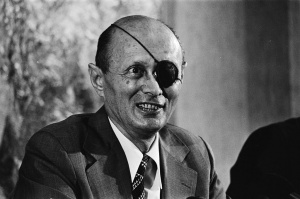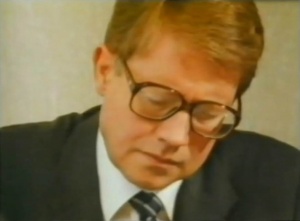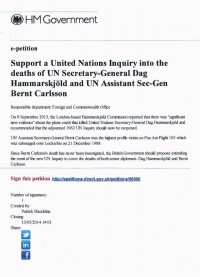Rössing Uranium Mine
(Mining) | |
|---|---|
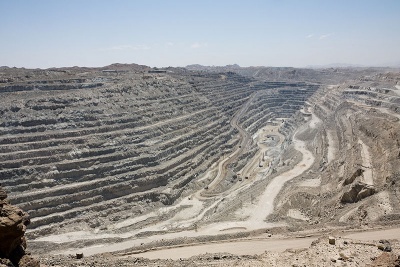 | |
Miners who dug uranium ore that supplied the British and US military in the 1970s with the raw material for bombs and civil nuclear power are reported to be dying of cancers and unexplained illnesses after working in one of Africa's largest mines.
A 2014 study based on questionnaires of current and former workers at the giant Rio Tinto-controlled Rössing Uranium Mine (RUM) in Namibia says that everyone questioned was aware of people who are now suffering lung infections and unknown illnesses thought to be linked to their work.[1]
Contents
- 1 Follow the Yellowcake Road
- 2 MI6 Connections
- 3 Namibian Yellowcake
- 4 Illegal mining
- 5 Ownership and Control
- 6 RTZ Mineral Services
- 7 Evading US anti-apartheid legislation
- 8 UNCN legal action
- 9 Bernt Carlsson lays down the law
- 10 Delay in closing the UF6 loophole
- 11 Handbagging the UN
- 12 URENCO case dropped
- 13 URENCO privatisation
- 14 United Nations Inquiry
- 15 "Lockerbie disaster kept Rössing in business"
- 16 Related Documents
- 17 References
- 18 See also
- 19 External links
Follow the Yellowcake Road
On 10 March 1980, when Follow the Yellowcake Road was broadcast in the UK by Thames Television, the TV documentary was signposting a 12-year journey that started four years earlier at the Rössing Uranium Mine in Namibia.[2] Synopsis of the film:
- "World In Action investigates the secret contract and operation arranged by British-based Rio Tinto Zinc Corp to import into Britain uranium (Yellowcake) from the Rössing Uranium Mine in Namibia, whose major shareholders are the governments of Iran and South Africa. This contract having received the blessing of the British government is now compromising the UK's position in the United Nations negotiations to remove apartheid South Africa from Namibia, which it is illegally occupying."[3]
Starting at the Rössing Uranium Mine in 1976, the Yellowcake Road continued through President P W Botha's South Africa and Ayatollah Khomeini’s Iran, and ended with the murder of United Nations Assistant Secretary-General and UN Commissioner for Namibia, Bernt Carlsson, on Pan Am Flight 103 at Lockerbie in Scotland on 21 December 1988.[4][5]
On 22 December 1988, President Ronald Reagan phoned Downing Street:
- "Margaret, I understand you have just returned from the site of the Pan Am crash. I want to thank you for your expression of sorrow on the Pan Am 103 tragedy. On behalf of the American people, I also want to thank the rescue workers who responded so quickly and courageously. Our thoughts and prayers are with the victims of this accident, both the passengers on the plane and the villagers in Scotland."[6]
Within four months of the Lockerbie disaster, Prime Minister Margaret Thatcher decided to make a whistle-stop tour of southern Africa,[7] and found time to visit Namibia's Rössing Uranium Mine where she was accompanied by David Cameron, then a youthful Conservative Central Office researcher.[8] Mrs Thatcher was so impressed by the Rössing Uranium Mine that she declared it made her "proud to be British".[9]
MI6 Connections
In February 2015, former secret agent Tony Holland revealed that he had been spying for MI6 in South Africa in 1969 when he worked as an engineer on the design of the Rössing opencast uranium mine which was being constructed in the Namibian desert for the international firm RTZ with South African and Iranian finance.
While working in South Africa for Fraser and Chalmers, an engineering subsidiary of the British firm Mitchell Cotts, Holland reported to MI6 in London on a meeting he attended in Johannesburg between mine engineers and the charismatic Israeli Defence Minister Moshe Dayan, who had signed a clandestine trade agreement under which South Africa ensured supplies of uranium oxide for the Israeli atom bomb project at Dimona.
Rössing became the world’s third-largest opencast uranium mine, lying in a desert that was controlled unlawfully by South Africa and therefore beyond the supervision of international inspectors. It became the source of un-monitored supplies of uranium oxide ‘Yellowcake’ for rogue nations seeking to develop nuclear weapons.
In an unpublished memoir, now being handled by Nick Hudson, the Australian publisher of Peter Wright's notorious book "Spycatcher", Tony Holland wrote:
- "Dayan wasn’t wearing his eye patch, and there was a gouged eye underneath.
- "We were told that if anyone recognised him and asked what he was doing in Johannesburg, we were to say that he was there for an operation on the eye.
- "They weren’t supposed to be developing their own bomb, but we helped them by turning a blind eye."[10]
Namibian Yellowcake
In 1976, Rössing Uranium Limited began operations by exporting Namibian Yellowcake (processed uranium ore). Rössing was jointly owned by British mining conglomerate Rio Tinto Group (RTZ), by the Atomic Energy Organisation of Iran (AEOI), by the South African parastatal entity known as the Industrial Development Corporation (IDC), which also controlled most of the voting shares, and by the French-based Total Compagnie Minière (TCF). Before the mine opened, RTZ had managed to secure large long-term contracts with German and Japanese utilities and with the United Kingdom Atomic Energy Authority (UKAEA). Within a very short time, Rössing had become the largest open pit uranium producer in the world.
Illegal mining
On some readings of international law, the Rössing operation was illegal right from the start since apartheid South Africa was continuing to occupy Namibia in defiance of UN Security Council Resolution 435.[11] The UN had formally ended South Africa’s mandate to govern the territory in 1966 by transferring that mandate to the newly created UN Council for Namibia (UNCN) pending the country's independence, and demanded the immediate withdrawal of South African troops. In 1971 the International Court of Justice ruled that these UN measures were binding and in 1973 the UN General Assembly recognised the freedom-fighting South West Africa People’s Organisation (SWAPO) as the "sole authentic representative" of the Namibian people.
In 1974 the UNCN issued Decree № 1, which prohibited the extraction and distribution of any natural resource from Namibian territory without the UNCN’s explicit permission, provided for the seizure of any illegally exported material, and warned that violators could be held liable for damages. Projected to be Namibia’s largest mining operation, Rössing thus became the primary target of Decree № 1. However, many Western governments (including the US and Britain) refused to accept Decree № 1 as binding, with lawyers and government officials disputing whether the decree was juridically sound, whether and how it might apply, and which courts might enforce its application. But the bottom line was that Rössing aimed to supply at least 10 percent of the global uranium market which translated into one-third of Britain’s needs, and probably more for Japan. Decree № 1 therefore sparked a lengthy international struggle over the legitimacy of Rössing uranium.
Starting in 1975, the UNCN sent out numerous delegations to convince governments to suspend their dealings with Namibia. They heard many expressions of support for the independence process, but prior to the mid-1980s only Sweden (among the large Western uranium consumers) pledged to boycott Rössing’s product. Activists stepped up the pressure in a wide variety of forums. In the UK and the Netherlands, they joined forces with the anti-nuclear movement, resulting in organisations like the British CANUC (Campaign Against the Namibian Uranium Contracts). The UNCN held a week-long hearing in July 1980, during which experts and activists from Europe, Japan, and the United States gave presentations on Rössing’s operations and contracts, and the TV documentary ‘Follow the Yellowcake Road’ was screened. Testimony focused on the relationship between southern Africa and the Western nuclear industry, arguing that all purchases of Namibian uranium effectively supported the colonial occupation via the taxes paid by the Rössing mine.
Ownership and Control
By 2007, shares in the Rössing Uranium Mine were owned 69% by the Rio Tinto Group, 15% by the Government of Iran (purchased in 1976), 10% by IDC of South Africa, 3% by the Government of Namibia (with 51% of voting rights), and 3% by local individual shareholders.[12]
Although Rössing's part-ownership by Iran was the cause of controversy in the 1970s and 1980s, the Namibian Government – in power since 1990 – has denied supplying Iran with Namibian uranium, which could be used for nuclear weapons.[13]
In an analysis of global uranium supply and demand, one economist (Stephen Ritterbus) noted that southern African uranium "could account for as much as 50 per cent of the total available for net export." Reminding his audience that South African (IDC) shares in Rössing gave the apartheid state voting control of the company, Ritterbus suggested that Pretoria thereby had "leverage not only as regards the supply and price of uranium but also as regards the formulation of foreign policy towards South Africa itself and [its] present position in Namibia."
In 1981, SWAPO helped organise a seminar for West European trade unions as well as presentations on living and working conditions at Rössing and on the mine’s paramilitary security forces, which appealed to the loyalties of the International Socialist movement. The seminar detailed the secret movements of Rössing uranium through European planes, ships, docks, and roads, noting that European transport workers had unknowingly handled barrels of radioactive substances. A 1982 seminar organised by the American Committee on Africa on the role of transnational corporations in Namibia focused heavily on uranium, reprising many of the arguments mounted by European activists. In subsequent years CANUC redoubled its efforts to enlist the British peace movement.
RTZ Mineral Services
Despite all the bad publicity, Rössing’s customers held firm in their contracts through the mid-1980s. The company helped: it responded to the pressure by papering over the transnational dimensions of its operations. To address "the unwillingness of certain customers to deal direct," RTZ set up a front company in Switzerland under the name RTZ Mineral Services (Minserve). Customers could thus sign contracts that didn’t mention Rössing, whereupon Minserve would sign corresponding "back-to-back" contracts with the mine. Minserve’s marketing emphasised that RTZ-owned uranium mines in three countries: should one mine prove unable to deliver, ore from elsewhere could take its place. Management referred to customers by number rather than name to reinforce discretion. This protected not just Rössing’s customers but also its board of directors, who officially remained ignorant of customer identity and contract prices. Until late 1985 (when the threat of sanctions made such topics impossible to ignore), the "market reports" Minserve delivered at company board meetings in Namibia’s capital Windhoek pointedly avoided discussing how anti-apartheid activism was constraining Rössing’s business. The omission was especially glaring because the reports discussed just about every other international political development affecting the flow of uranium.
Nevertheless, records of Minserve’s London sales meetings show that customers began expressing unease in the early 1980s. Japanese utilities in particular worried that their government might cave to international pressure and began asking Minserve to substitute non-Namibian origin material. In order to secure new contracts, Minserve had to devise increasingly arcane arrangements. In September 1983, for example, one customer who had previously held a direct contract with Rössing made a new inquiry. A sales associate reported: "Politically [they] cannot buy Namibian material but they are willing to discuss taking swapped material in the form of spot deliveries of UF6 [uranium hexafluoride, the feed for enrichment plants]. Any contract should preferably be with a third party, either the converter or the contracting party and not an RTZ Company."
Minserve’s role as a front was an open secret, and utilities increasingly sought to maximise their distance from RTZ. As international pressure for Namibian independence mounted, Rössing and Minserve began using "flag swaps" to fulfil contracts. Such arrangements could follow several scenarios. In one, the material would be re-labelled by conversion plants. Comurhex (in France) and BNFL (in Britain) proved particularly co-operative: after they converted Rössing’s Yellowcake into uranium hexafluoride, they would state its origin as French or British on the customs forms accompanying the material to US enrichment plants. In a second scenario, Minserve would swap contracts with another RTZ customer: the contract originally intended to use Rössing Yellowcake would get filled with uranium from another RTZ mine, while the contract signed by that mine would get filled with Rössing uranium. This scenario depended on the willingness of the other RTZ customer to accept Namibian uranium; Swiss utilities usually obliged happily. Yet another scenario involved two conversion plants shuffling titles to uranium oxide and hexafluoride. All told, the quantity of swapped material rose from several hundred tonnes in 1982 to several thousand by 1985–1986.
At first, the pressures that made Rössing uranium increasingly illicit also made it more profitable. Sales contracts were denominated in US$ but most costs were incurred in South African Rand. As opposition to apartheid drove down the value of the Rand, profits mounted: in 1985 Rössing showed the highest profit to date, recorded at over 190 million Rand after taxes. This was especially remarkable given "the continued weakness in the world uranium market." Still, a favourable exchange rate would not help if Rössing lost all its buyers. Talks on Namibian independence had stalled and South African state violence had intensified. In 1985 even the staunchest allies of the apartheid state began discussing full-scale mandatory sanctions. Rössing didn’t fret too much about interruptions to its supply chain, since it could circumvent restrictions with purchasing agents, offshore accounts, and more front companies. But Minserve did worry about specific prohibitions on the import of Namibian uranium: Rössing’s main customers had "enough of the product and could manage quite well without buying any more. [They] might welcome an excuse to renege on their contract."
At best, flag swaps and related measures would only give Rössing some breathing space. "We have to accept that in any coordinated imposition of sanctions uranium is the easiest material for the authorities to trace and block. Without the assistance of the converter or the falsification of origin records it is inevitable that the sales of Rössing material will be severely curtailed. Any study on the counter effects of sanctions on Rössing has therefore to be one of damage limitation."
Evading US anti-apartheid legislation
One form of damage limitation involved working the finer points of anti-apartheid legislation, particularly after the US Congress overrode President Reagan’s veto of the Comprehensive Anti-Apartheid Act (CAAA) in October 1986. The CAAA's threat to Rössing were considerable: a significant portion of its Yellowcake went to plants in America for conversion to hexafluoride. In addition, much of Rössing’s Yellowcake converted elsewhere went to US plants for enrichment. Stopping the flow of Namibian-origin uranium oxide or hexafluoride through US plants could therefore shut down Rössing’s business altogether. To help work around the CAAA, Minserve hired the consulting firm Wrightmon USA for a monthly retainer of $15,000.
Diane Harmon, the firm’s president, employed a double strategy to maximise the amount of Namibian uranium imported into America. On the one hand, she formed an alliance with US conversion plants which stood to lose a lot of money if Rössing’s business disappeared. On the other hand, she also exploited a loophole in the CAAA that went against the interests of the converters. Rössing Yellowcake that entered the US directly clearly counted as Namibian. But if that Yellowcake got converted and re-labelled as British UF6, hadn’t its nationality changed? In which case, surely it could enter the US as enrichment feed? If Rössing transferred all its conversion business to European plants, its customers could maintain their US enrichment contracts. Harmon pointed out that US enrichment plants would suffer if they lost southern African feed; combined with other import restrictions, the impact might force one of the plants to close. Job losses would ensue. By the end of 1987, Harmon had obtained a ruling that: South African–origin uranium ore and uranium oxide that is substantially transformed into another form of uranium in a country other than South Africa is not to be treated as South African uranium ore or uranium oxide and is therefore not barred. This became known as the "UF6 loophole." Pleased with this outcome, Minserve asked Sir Alistair Frame, RTZ’s well-connected chairman, to "have a word" with BNFL and the British Foreign Office to ensure that they continued to re-label converted material as UK-origin.
UNCN legal action
In May 1985, the United Nations Council for Namibia (UNCN) began legal action against URENCO - the joint Dutch/British/West German uranium enrichment company, with plants in Capenhurst (Cheshire, England), Almelo (Netherlands) and Gronau (West Germany). Since URENCO had been importing uranium ore from the Rössing Uranium Mine in Namibia, the company was charged with breaching UNCN Decree № 1. The case was expected to be ready by the end of 1985 but was delayed because URENCO argued that - despite having enriched uranium of Namibian origin since 1980 - it was impossible to tell where specific consignments came from. When the case finally reached court in July 1986, the Dutch government took URENCO's line, claiming not to have known where the uranium had been mined. [14] Upon the adjournment of the URENCO proceedings, SWAPO's UN representative, Helmut Angula, insisted that other companies, such as Shell, De Beers (Consolidated Diamond Mines), Newmont, and Rio Tinto were also likely to face prosecution for breaching the UNCN Decree.
Bernt Carlsson lays down the law
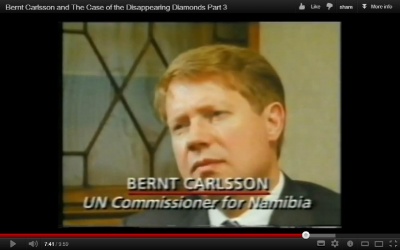
The man responsible for Namibia under international law, Assistant Secretary-General of the United Nations and UN Commissioner for Namibia, Bernt Carlsson, spoke about these prosecutions in a World In Action TV documentary "The Case of the Disappearing Diamonds" which was broadcast by Thames Television in September 1987:
- "The United Nations this year in July started legal action against one such company - the Dutch company URENCO which imports uranium."
When asked if he would be taking action against other companies such as De Beers, the diamond mining conglomerate, Bernt Carlsson replied:
- "All the companies which are carrying out activities in Namibia which have not been authorised by the United Nations are being studied at present. As far as De Beers is concerned, the corporation has been trying to skim the cream which means they have gone for the large diamonds at the expense of the steady pace. In this way they have really shortened the lifespan of the mines. One would expect from a worldwide corporation like De Beers and Anglo American that they would behave with an element of social and political responsibility. But their behaviour in the specific case of Namibia has been one of profit maximation regardless of its social, economic, political and even legal responsibility."[15]
Delay in closing the UF6 loophole
In 1988, US Congressional Democrats began working to close the UF6 loophole. The State Department’s Office of Non-proliferation and Export Policy did as well, declaring:
- "It is not possible to avoid the provisions of the Comprehensive Anti-Apartheid Act by swapping flags or obligations on natural uranium physically of South African origin before it enters the USA."
Nevertheless, Rössing managed to delay the implementation of restrictions which could have put it out of business. And - in the end - that delay sufficed: apartheid South Africa and other negotiating parties signed an independence accord on 22 December 1988. On his way to the signing of the agreement at UN headquarters in New York, UN Commissioner Bernt Carlsson became the highest profile victim of the Pan Am Flight 103 crash at Lockerbie on 21 December 1988.
Handbagging the UN
In March 1989, while Mrs Thatcher was in Namibia, she put improper pressure on the UN's man, Martti Ahtisaari, head of the United Nations Transition Assistance Group, to permit the South African Defence Force (SADF) to take action against SWAPO soldiers who were peacefully returning to Namibia to vote in the November 1989 independence elections. As a result, as many as 308 SWAPO soldiers were killed - "shot in the back" according to former SADF major Nico Basson. Whether Mrs Thatcher could have persuaded UN Commissioner for Namibia, Bernt Carlsson, to agree to such treachery we shall never know since Mr Carlsson was assassinated fifteen weeks earlier, on 21 December 1988.[16]
URENCO case dropped
Following Bernt Carlsson's untimely death in the Lockerbie bombing, the case against URENCO was inexplicably dropped and no further prosecutions took place of the companies and countries that were in breach of the United Nations Council for Namibia Decree № 1.
Despite this fairly obvious evidence that Bernt Carlsson was the prime target on Pan Am Flight 103, there has never been a murder investigation conducted by the CIA, FBI, Scottish Police or indeed by the United Nations.
Instead, fabricated evidence has been used to frame and wrongfully convict the Libyan Abdelbaset al-Megrahi for the crime of Lockerbie.[17]
URENCO privatisation
On 22 April 2013, David Cameron's coalition government announced plans to sell its share in URENCO - the uranium enrichment company owned by Britain, Germany and the Netherlands - unleashing a new wave of privatisations in an attempt to cut the public debt. The UK government’s one-third share in URENCO could fetch up to £3bn, making it one of the biggest privatisations in the UK in years.[18]
Headquartered in the semi-rural Buckinghamshire village of Stoke Poges, where, appropriately enough given its atomic plot, "Goldfinger" was partly shot, URENCO has a 31 per cent share of the world's uranium enrichment market. This provides the fuel for nuclear power utilities and URENCO has enrichment plants in the US and the three investor countries, including one in Capenhurst, Cheshire.
- "It's a ridiculous idea," according to the GMB union's national secretary for energy Gary Smith, who earlier this week complained to The Independent of the prospect of the Chinese investing in the nuclear new-build programme. "We're flogging off precious nuclear assets instead of developing a strategy around nuclear. It's absolute madness."[19]
By privatising URENCO, the British government is presumably hoping to bring closure to the Lockerbie affair, and thus escape prosecution for the Thatcher administration's criminal behaviour in processing Namibian Yellowcake contrary to United Nations Council for Namibia Decree № 1.
United Nations Inquiry
In November 2013, former diplomat Patrick Haseldine created this e-petition calling upon HM Government (Foreign and Commonwealth Office) to:
- "Support a United Nations Inquiry into the deaths of UN Secretary-General Dag Hammarskjöld and UN Assistant Secretary-General Bernt Carlsson"
- On 9 September 2013, the London-based Hammarskjöld Commission reported that there was "significant new evidence" about the plane crash that killed United Nations Secretary-General Dag Hammarskjöld and recommended that the adjourned 1962 UN Inquiry should now be reopened.
- UN Assistant Secretary-General Bernt Carlsson was the highest profile victim on Pan Am Flight 103 which was sabotaged over Lockerbie on 21 December 1988.
- Since Bernt Carlsson's death has never been investigated, the British Government should propose extending the remit of the new UN Inquiry to cover the deaths of both senior diplomats: Dag Hammarskjöld and Bernt Carlsson.
The e-petition is open for signature by UK citizens and residents from 13 November 2013 to 13 May 2014, and can be signed here.[20]
Lord Kinnock's response
On 12 December 2013, Lord Kinnock responded to Haseldine's email requesting his support for this UN Inquiry, as follows:
- Dear Prof Haseldine,
- Thank you for your note.
- I am prepared to support the call for an UN Inquiry.
- Regards,
"Lockerbie disaster kept Rössing in business"
On 6 January 2014, The Ecologist published an article by Patrick Haseldine entitled "Flight 103: it was the Uranium".[21] Two days later, the Namibian Sun newspaper carried a full report on the article under the headline "Lockerbie disaster kept Rössing in business".[22]
Related Documents
| Title | Type | Publication date | Author(s) | Description |
|---|---|---|---|---|
| Document:Pan Am Flight 103: It was the Uranium | article | 6 January 2014 | Patrick Haseldine | Following Bernt Carlsson's untimely death in the Lockerbie bombing, the UN Council for Namibia inexplicably dropped the case against Britain's URENCO for illegally importing yellowcake from the Rössing Uranium Mine in Namibia. |
| Document:The Rossing File:The Inside Story of Britain's Secret Contract for Namibian Uranium | pamphlet | 1 January 1980 | Alun Roberts | Scandal in the 1970s and 1980s of collusion by successive British governments with the mining conglomerate Rio Tinto to import yellowcake from the Rössing Uranium Mine in Namibia (illegally occupied by apartheid South Africa) in defiance of international law, and leading to the targeting of UN Commissioner for Namibia Bernt Carlsson on Pan Am Flight 103 in December 1988. |
References
- ↑ "Uranium workers dying after time at Namibia mine, report warns"
- ↑ "Follow The Yellowcake Road"
- ↑ World In Action "Follow The Yellowcake Road"
- ↑ "Follow The Yellowcake Road That Led To Lockerbie"
- ↑ "Lockerbie: Ayatollah's Vengeance Exacted By Botha's Regime"
- ↑ "Reagan call to Thatcher (Lockerbie)"
- ↑ Robin Oakley, 'Thatcher pursues role as peace broker; Tour of African nations', The Times (27 March 1989)
- ↑ "Cameron's freebie to apartheid South Africa"
- ↑ "The Gulliver Rössing Uranium Ltd Dossier"
- ↑ "Ex-spook admits giving ‘big, big’ names to sex dossier MP" Tribune magazine, 4 February 2015
- ↑ "UN Security Council Resolution 435 of 29 September 1978"
- ↑ "Rössing's business at a glance – 2007"
- ↑ "Iran did not buy uranium from Namibia" – The Namibian, 1 February 2005
- ↑ David de Beer, The Netherlands, Namibian uranium and the Implementation of Decree No. 1, Working Group Kairos, Brussels, 1986
- ↑ "Bernt Carlsson and the Case of the Disappearing Diamonds"
- ↑ "Missing diplomatic links and the Lockerbie tragedy"
- ↑ "Fragment of the imagination?"
- ↑ "Osborne eyes Urenco sale windfall"
- ↑ "URENCO move: Shadow over next big state sell-off"
- ↑ "Support a United Nations Inquiry into the deaths of UN Secretary-General Dag Hammarskjöld and UN Assistant Secretary-General Bernt Carlsson"
- ↑ "Flight 103: it was the Uranium"
- ↑ "Lockerbie disaster kept Rössing in business"
See also
External links
- UN Security Council Resolution 418 of 4 November 1977
- Being Nuclear: Africans and the Global Uranium Trade by Gabrielle Hecht, Professor of History at the University of Michigan
- The Power of Nuclear Things by Prof Gabrielle Hecht
- Uranium from Africa and the Power of Nuclear Things
- The Gulliver Rössing Uranium Ltd Dossier
- Who targeted Bernt Carlsson on Pan Am Flight 103?
- 'Bernt Carlsson and the Case of the Disappearing Diamonds'
- Gordon Brown says Lockerbie victim Bernt Carlsson was the target
- Lockerbie: Ayatollah's Vengeance Exacted by Botha's Regime
- 'Lockerbie Conspiracy' by Thatcher and Reagan
- Lockerbie: Cameron's Nuclear Secret
- Lockerbie PMQs for David Cameron
- 'Follow the Yellowcake Road' Investigates the secret contract and operation arranged by the British-based Rio Tinto Group to import Yellowcake into Britain from the Rössing Uranium Mine in Namibia, whose major shareholders are the Iranian and South African governments.
